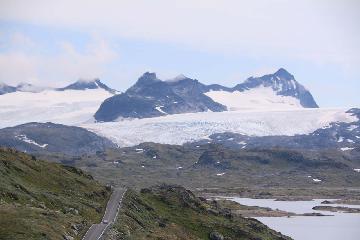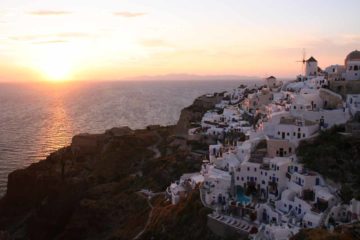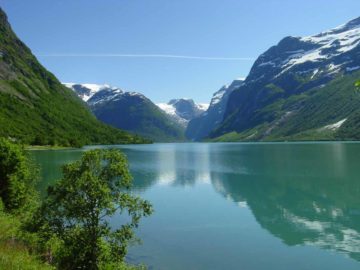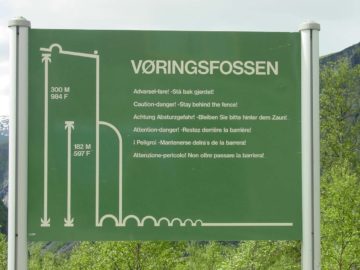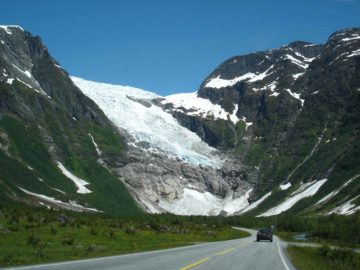About Krunefossen and the Kjenndalen Waterfalls
Krunefossen was a gushing waterfall at the terminus of the Krunebreen arm of the vast Jostedalsbreen Glacier.
According to my Norgeskart measurements, the entire waterfall lost about 480m in elevation over its entire run from the mountain top (where the glacier still sat as of our 2019 visit to Norway) to the floor of the valley below.
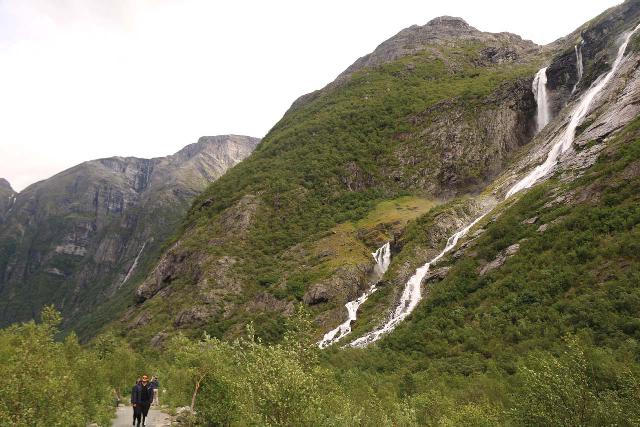
Over its steepest section, I measured on the order of a 220m loss in elevation.
So this would really put Krunefossen as one of the higher waterfalls in Norway.
However, I’m really starting to question that particular metric considering waterfalls are everywhere in Norway and there’s a rather loose definition of what consitutes a waterfall.
As for witnessing this waterfall, all we really had to do was to drive all the way to the head of the Kjenndal Valley (Kjenndalen) since it was quite visible from the road.
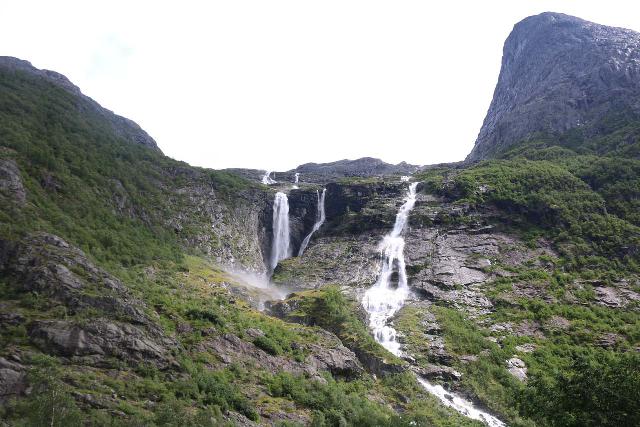
However, there’s a lot more than meets the eye with Krunefossen, which we’ll get into below…
The Glacier Waterfall Phenomenon
After visiting Krunefossen for our first time in July 2019, I tend to think of Krunefossen as a specific example of a series of waterfalls I’m dubbing the “glacier waterfalls”.
By that I mean waterfalls that directly result from melting ice at the terminus of a glacier.
Particularly in the face of Global Warming, we’ve certainly observed (especially in Norway) that the former locations of glacier arms have become locations of new waterfalls.
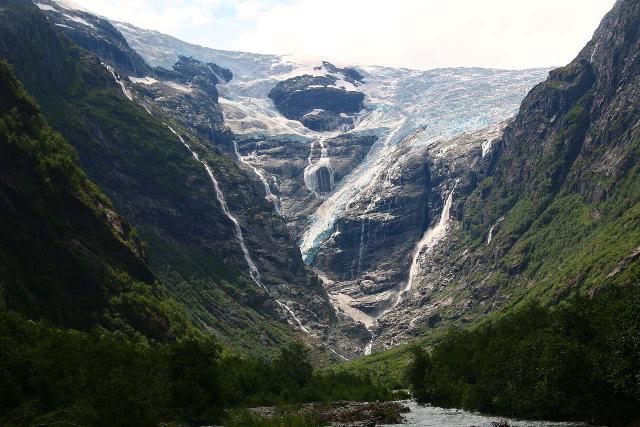
We even documented our experiences (spanning 14 years) at the terminus of the Briksdal Glacier confirming this phenomenon.
Indeed, we saw that the Krunebreen Glacier arm of the Jostedalsbreen Glacier rapidly receded and continues to grow this waterfall (and other segments of it) even more.
In fact, Krunefossen and Krunebreen sat in a side “valley” at the head of the Kjenndal Valley (Kjenndalen), which itself had a neighboring glacier with its new waterfalls at the Kjenndalsbreen Glacier.
Not only did the head of this valley feature this pair of glacier arms with their associated waterfalls, but it also featured a handful of other waterfalls as well!
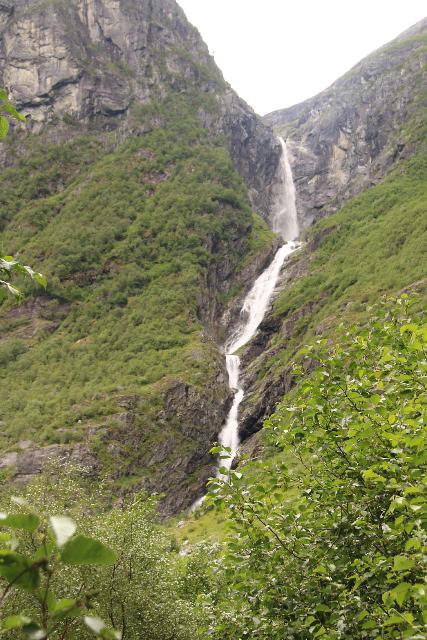
The end result was a situation where we were quite literally surrounded by waterfalls.
The high scenic rating you see on this page was largely a result of this concentration of waterfalls in one place thanks to this waterfalls-replacing-gone-glaciers phenomenon.
Really, our experience with Krunefossen and the neighboring waterfalls have made us re-evaluate how we have considered other glaicer-fed waterfalls such as the nearby Ramnefjellsfossen.
Internationally, there was even a glacier in Iceland called Morsárjökull that receded enough in to create a new waterfall called Morsárfoss that supplanted Glymur as the country’s tallest.
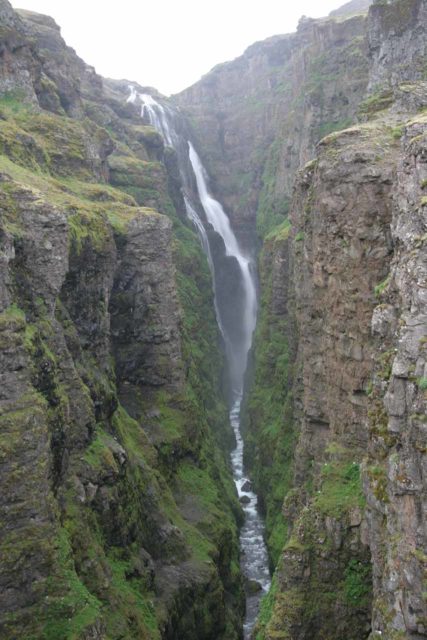
Indeed, I tend to think that with the acceleration of the decline of glaciers worldwide, this phenomenon will continue with greater regularity until the ice supply runs out.
Perhaps, the seasonal nature of Yosemite Falls would be how such waterfalls would behave once the glaciers disappear.
And thus, Julie and I had this strange feeling where we were torn between being blown away by the natural beauty of this waterfall display while at the same time melancholic about why this was happening along with its consequences.
Experiencing the Kjenndal Valley
Krunefossen was essentially a roadside experience as we spotted it right at the end of the road near the head of Kjenndalen, which fed into the larger Lodal Valley (Lodalen).
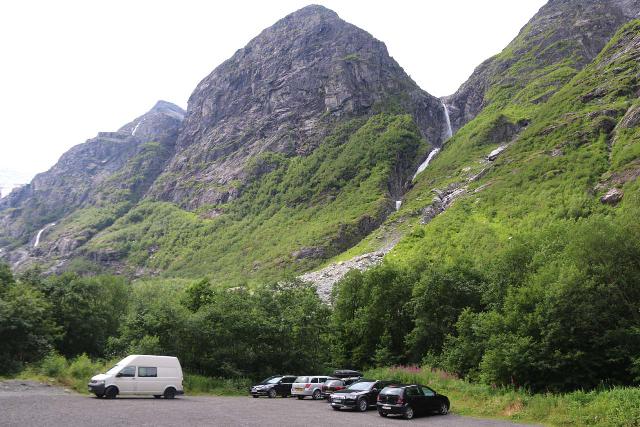
From the car park (see directions below), we really didn’t have to walk.
All we had to do was walk around the large car park and turn around for a 360-degree view as we were literally surrounded by waterfalls in almost all directions!
Krunefossen was merely just one of the waterfalls though it was definitely the highest volume one of the lot.
There was also a short footpath that went further up Kjenndalen towards the terminus of the Kjenndalsbreen Glacier, which was the dramatic glacier arm at the very head of this valley.
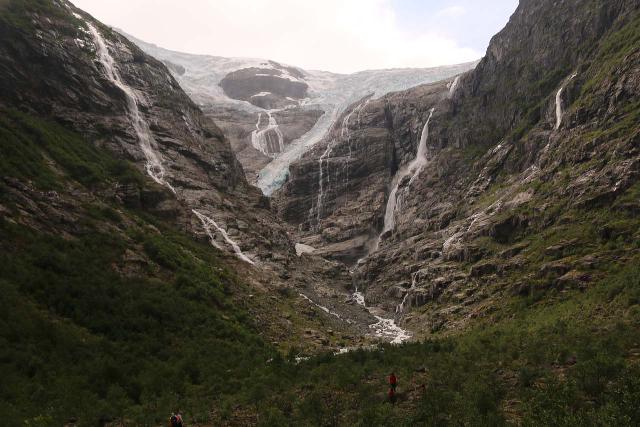
I could see that the glacier once licked the valley floor and the trail would have taken us to its terminus years ago, but as of our visit in 2019, only rock climbers or mountaineers would have a chance at even getting to the current glacier terminus.
This flat 400m walk only took about 15-20 minutes (each way) before we had our fill and turned back.
We should also note that the drive to the Krunefossen and Kjenndalsbreen also passed by Ramnefjellsfossen and a side excursion up Bødalen Valley.
However, we have separate write-ups for those excursions since this page focuses more on Krunefossen and how it spotlighted the glaciers and the waterfall-glacier relationship.
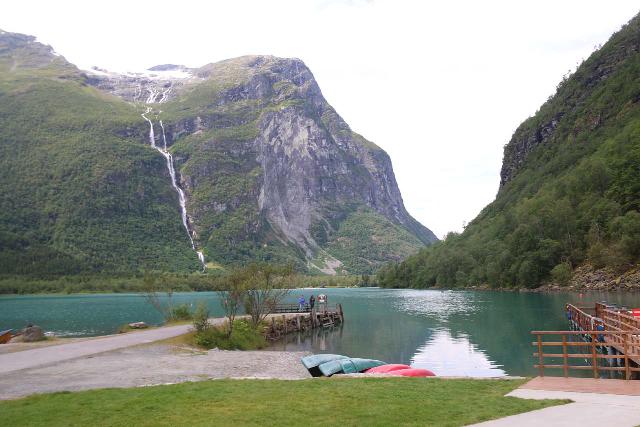
On this page, we’re more focused on the glaciers and the very head of this glacially-carved valley.
Authorities
Krunefossen resides in the Stryn Municipality. For information or inquiries about the area as well as current conditions, visit their website or Facebook page.
Related Top 10 Lists
No Posts Found
Trip Planning Resources
Nearby Accommodations
This content is for members only. See Membership Options.Featured Images and Nearby Attractions
This content is for members only. See Membership Options.Visitor Comments:
Got something you'd like to share or say to keep the conversation going? Feel free to leave a comment below...No users have replied to the content on this page
Visitor Reviews of this Waterfall:
If you have a waterfall story or write-up that you'd like to share, feel free to click the button below and fill out the form...No users have submitted a write-up/review of this waterfall

